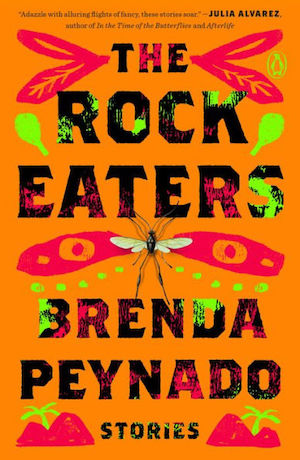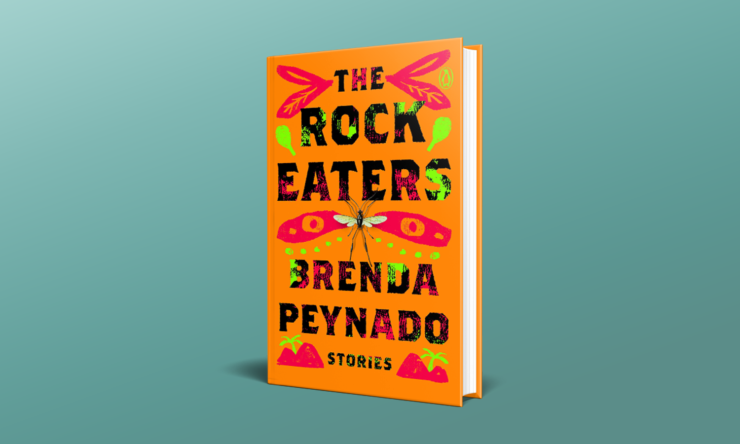Brenda Peynado’s debut book, The Rock Eaters, a short-story collection that bounces around genres such as speculative fiction, science fiction and straight fiction, will definitely leave you deeply unsettled, though perhaps not always in a good way.
Peynado’s is a gifted, imaginative writer and I admit I was prepared to be blown away after reading the book’s introductory story, “Thoughts and Prayers,” a stunning, ironic piece about a world where angels perch on people’s roofs, their actual physical presence akin to cows as they chew “cud from the grasses and bugs they scavenged during the night,” while in the morning the people emerged from their houses to shout “thoughts and prayers” at them to prevent bad luck overtaking them. Centering around a young girl who lives in one of the most “blessed” houses who is best friends with another girl whose family’s angel is next to worthless and is continually beset by tragedy. When Rima’s kind, seemingly lucky older sister is killed by a school shooter, and the Mothers For the Sanctity of the World and their husbands, the Good Guys With Guns arrive to turn the already surreal tragedy into a mass type of martyrdom.
The pain and sadism the right’s empty religiosity and worship of weapons and “might makes right” mentality are twisted into a black, tragic humor in this story. The layers are both intricate and violently obvious and no one is absolved, especially not the well-to-do Latinx suburban population, which is refreshing. It’s the type of story that knocks you out with a brilliant right hook to the jaw.
Buy the Book


The Rock Eaters
The next story, “The Stones of Sorrow Lake,” isn’t quite as strong but still firmly speculative fiction and a solid, imaginative tale about a young Latinx woman who follows her white boyfriend back to his hometown, where its main feature is a “lake of sorrow.” Each time the residents have their first great grief, a stone forms somewhere on or in their bodies, which they eventually release on the shore of the lake. This inextricably ties them to the town, even the ones who escape eventually go back again and again. Their first day in the town, during a welcome home party, she is caught forever in the town’s infinite tragedy.
Peynado shows another interesting strength in highlighting class differences and prejudices in “The Whitest Girl” and “Yaiza,” though neither could be considered speculative fiction. In “The Whitest Girl,” she uses a first-person plural in a clever way to illustrate all the girls in a Catholic high school, mostly Latinx and well off, who fetishize and terrorize a poor white girl, Terry Pruitt, who arrives at their school on a scholarship. They stalk her to her home in a trailer park, shadow her at school to learn everything about her, repulsed as they are, as if she is a sideshow freak. It’s a clever twist, to otherize someone who would, normally, otherize the Black and brown girls. However, it’s Terry’s seeming ability to ignore their antics that drives them to a frenzy to find something to unmake her world, that innate cruelty of teenage girls.
In “Yaiza,” that envy makes a subtle change when a girl who finds herself in a fierce competition with her housekeeper’s granddaughter, Yaiza, at their tennis club. Despite running across the freeway to get to lessons and playing with a frayed, old racket, Yaiza’s preternatural talent means she overtakes the “favorite” position as the other girl. Still, they find ways to be human to each other in their own ways when each girl suffers an unfortunate incident. However, when the protagonist gives Yaiza her spare racket so they can play each other fairly during their tournament match that leads to her mother firing Yaiza’s grandmother, insisting she is a thief. Both families are Latinx and it Peynado displays that brutal class disparity perfectly.
Strangely, the two straight science-fiction stories in the collection, though solid, were not as compelling. “The Kite Maker” is about a future where a mother who is tormented by her and all the other humans’ brutal slaughter of a peaceful, dragonfly-like alien race who escaped the devastation of their home planet with only enough fuel to reach Earth. Treated as unwanted immigrants, much like our own Latinx people, the aliens are obsessed with buying her handmade kites to fly, as it reminds them of their home as they bob in the sky. A bit heavy-handed in the otherization and “human” (i.e. white) supremacist groups who come after them, the mother still manages to commit a type of rape against one of the aliens. It was definitely disturbing but I couldn’t stop thinking about the movie, “District 9,” which deals with many of the same themes.
Likewise, in “The Touch,” I was reminded of a combination of “The Matrix” and “Avatar,” though with a more modern pandemic twist, where in a future destroyed by deadly diseases unleashed by the destruction of deforestation and melting of the polar ice caps, people are born in cubicles, which they usually never leave, assigned a caretaking robot for the “dirty” world. They hook into a matrix-like system to interact with “clean” with avatars. The main character is a scientist seemingly disgusted by the idea of being physically touched but she begins a transformation after being compromised during an accident in “dirty” and the specter of death crawls inside. Though interesting, the story lacked a deeper emotional resonance between its characters that would have turned it from a slightly dry sci-fi piece to something truly transcendent and original.
Ideally, one wants to feel firmly placed within an author’s universe in a short-story collection, even when the stories, characters, and landscapes change. However, The Rock Eaters lacks a cohesiveness to help ground the reader in Peynado’s world. Whether by intention or accident, the stories’ broad sweep through different genres jostles you unnecessarily and keeps you from settling more deeply into what continually promised to be a truly stunning debut collection. Still, many of stories are engaging and original, so while not a knock-it-out-of-the-park victory, it is still a success.
The Rock Eaters is available from Penguin Books.
Angela Maria Spring is the owner of Duende District, a mobile boutique bookstore by and for people of color, where all are welcome. She holds an M.F.A. in poetry from Sarah Lawrence College, was a 2018 Kirkus Fiction Prize judge, and has work forthcoming in Radar Poetry, Pilgrimage, Borderlands: Texas Poetry Review, and Third Wednesday. You can find her on Twitter at @BurquenaBoricua or at duendedistrict.com.










